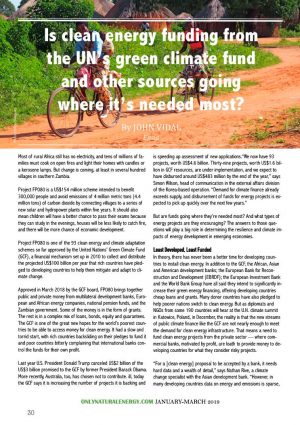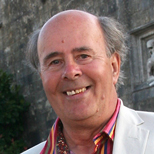 Most of rural Africa still has no electricity, and tens of millions of families must cook on open fires and light their homes with candles or a kerosene lamps. But change is coming, at least in several hundred villages in southern Zambia.
Most of rural Africa still has no electricity, and tens of millions of families must cook on open fires and light their homes with candles or a kerosene lamps. But change is coming, at least in several hundred villages in southern Zambia.
Project FP080 is a US$154 million scheme intended to benefit 300,000 people and avoid emissions of 4 million metric tons (4.4 million tons) of carbon dioxide by connecting villages to a series of new solar and hydropower plants within five years. It should also mean children will have a better chance to pass their exams because they can study in the evenings, houses will be less likely to catch fire, and there will be more chance of economic development.
Project FP080 is one of the 93 clean energy and climate adaptation schemes so far approved by the United Nations’ Green Climate Fund (GCF), a financial mechanism set up in 2010 to collect and distribute the projected US$100 billion per year that rich countries have pledged to developing countries to help them mitigate and adapt to climate change.
Approved in March 2018 by the GCF board, FP080 brings together public and private money from multilateral development banks, European and African energy companies, national pension funds, and the Zambian government. Some of the money is in the form of grants. The rest is in a complex mix of loans, bonds, equity and guarantees. The GCF is one of the great new hopes for the world’s poorest countries to be able to access money for clean energy. It had a slow and torrid start, with rich countries backsliding on their pledges to fund it and poor countries bitterly complaining that international banks control the funds for their own profit.
Last year U.S. President Donald Trump canceled US$2 billion of the US$3 billion promised to the GCF by former President Barack Obama. More recently, Australia, too, has chosen not to contribute. ill, today the GCF says it is increasing the number of projects it is backing and is speeding up assessment of new applications.“We now have 93 projects, worth US$4.6 billion. Thirty-nine projects, worth US$1.6 billion in GCF resources, are under implementation, and we expect to have disbursed around US$483 million by the end of the year,” says Simon Wilson, head of communication in the external affairs division of the Korea-based operation. “Demand for climate finance already exceeds supply, and disbursement of funds for energy projects is expected to pick up quickly over the next few years.”
But are funds going where they’re needed most? And what types of energy projects are they encouraging? The answers to those questions will play a big role in determining the resilience and climate impacts of energy development in emerging economies.
Least Developed, Least Funded
In theory, there has never been a better time for developing countries to install clean energy. In addition to the GCF, the African, Asian and American development banks; the European Bank for Reconstruction and Development (EBRDF); the European Investment Bank and the World Bank Group have all said they intend to significantly increase their green energy financing, offering developing countries cheap loans and grants. Many donor countries have also pledged to help poorer nations switch to clean energy. But as diplomats and NGOs from some 190 countries will hear at the U.N. climate summit in Katowice, Poland, in December, the reality is that the new streams of public climate finance like the GCF are not nearly enough to meet the demand for clean energy infrastructure. That means a need to fund clean energy projects from the private sector — where commercial banks, motivated by profit, are loath to provide money to developing countries for what they consider risky projects.
“For a [clean energy] proposal to be accepted by a bank, it needs hard data and a wealth of detail,” says Nathan Rive, a climate change specialist with the Asian development bank. “However, in many developing countries data on energy and emissions is sparse, unavailable or unreliable, making detailed project-specific climate assessments difficult. Other countries do not have adequate monitoring or evaluation systems to keep track of projects.”
The resulting bias toward more developed countries is stark. Of the roughly US$333 billion estimated by financial research group Bloomberg NEF to have been invested worldwide in renewable energy in 2017, nearly US$280 billion went to China, the U.S., Canada, Europe, Japan and Australia. A handful of middle income countries like Mexico and South Korea. India, Brazil and Egypt absorbed a further US$28 billion. The remaining countries attracted just about US$25 billion among them, despite having over one-third of the world’s population.
In fact, consultants working with ministers and banks to raise clean energy finance say the world’s 47 least developed countries and the 39 small island developing states are barely on the financial map. “There are major challenges in reaching least developed countries (LDCs) and small island developing states (SIDs), due to a lack of sophisticated capital. As a result of this …. renewable energy projects tend to be located in middle-income countries,” says Virginie Fayolle, a senior economist who leads climate finance at Acclimatise, a U.K.-based consultancy which has advised the governments of Swaziland, Bangladesh, Guyana and other developing countries on how to access climate finance.
Infrastructure Challenges
The nature of energy infrastructure needs affects willingness to invest as well. Developing countries require a higher level of investment in infrastructure, such as small-scale, off-grid and decentralized projects, to reach more remote populations, says Ming Yang, a senior climate change specialist at the Global Environment Facility (GEF), which has provided more money for small-scale electrification in developing countries than any other funder in the past 30 years. Between October 1991 and August 2017, the GEF granted US$1.19 billion to 254 renewable energy projects. Of these, 43 percent are microgrids, mini-grids or decentralized, says Yang. The problem, he says, is that financing clean energy for the poorest is getting harder, and new technology systems and financial instruments are needed. “Electric companies and energy suppliers [may] defer expanding access to economically disadvantaged areas because it is not perceived as financially viable,” says Yang.
“National planners [in developing countries] hesitate to promote renewable energy–based micro-grids because they are thought relatively more expensive than fossil-fuel energy technologies. For a variety of social and political reasons, government agencies also give higher priority for expanding access for urban, rather than rural, areas.”
Wilson says over 40 percent of the GCF’s projects are micro- or small-scale investments of under US$250,000, and there is no preference for large projects over smaller ones. But Neha Rai, a senior researcher at London-based International Institute for Environment and Development (IIED) says little of international climate money is funding decentralized energy. “Of the US$14 billion approved so far for climate finance, about 40 percent, or US$5.6 billion, has been marked for energy projects. But only 3 percent (US$475 million) has been allocated for decentralized energy. That is the equivalent of just US$51 million a year between 2006 and 2015, the period for which data on clean energy finance is available,” she says.
Climate Catch-22
Ironically, climate change may be making it even harder for developing countries to raise money for renewable energy projects. Particularly vulnerable ones, such as Bangladesh and small island states, must pay more to borrow because climate change is regarded by banks as an extra financial risk, according to a new U.N. Environment Programme–backed study. Researchers who examined the financial data of 48 developing countries, including Bangladesh, Guatemala, Kenya and Vietnam, found that vulnerable countries have had to pay an extra US$62 billion for capital over the past 10 years. “Climate vulnerability has already raised the average cost of borrowing to developing countries through higher interest rates. We expect the additional interest payments attributable to climate vulnerability to increase to between US$146 and US$188 billion over the next decade,” says Charles Donovan, director of the Centre for Climate Finance at Imperial College Business School.
Solutions
lWithout more clean energy funding, say non-government groups including Third World Network, U.S. Climate Action Network and Greenpeace International, it’s unlikely that most developing countries will be able to meet their commitments made in Paris in 2015 to reduce CO2 emissions, adapt to climate change and meet the U.N. goal of providing electricity to the 1 billion people presently without it.
“The problem is not that there is not enough money. It is lack of political will. There is definitely institutional bias against poor countries when it comes to sustainable energy,” says Lidy Nacpil, coordinator of the Asian Peoples’ Movement on Debt and Development (APMDD).“We see renewable energy as a public good and say that governments and international financial institutions should use public funds not to guarantee and absorb the risks of the private sector, but to take the lead in developing democratic renewable energy systems.”
Developing countries must fight for every dollar of climate cash. Larger ones, like Bangladesh and Ethiopia, have the human resources and technical data to convince the funding bodies of their case. Egypt has been one of the most successful countries to access money for clean energy projects, thanks to government commitment to economic reforms and its potential for wind and solar. By 2019, 37 square kilometers (14 square miles) of desert near the village of Benban, outside Aswan, should be covered with solar panels — potentially one of the world’s largest solar parks.
Yasmin Fouad, environment minister of Egypt, is cautiously optimistic. “It’s never been easy for countries like Egypt to raise money for clean energy,” she says. “But we now have three projects with the GCF and will be submitting more. It’s not easier to raise the money, but we can say the situation is getting a bit better.”
John Vidal
Originally published
by Ensia.com
November 29, 2018

